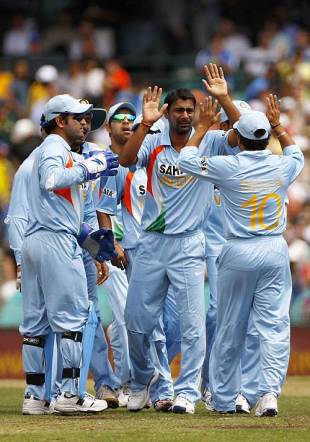|
|
|

Praveen Kumar's simple approach played a key role in India's victory
© Getty Images
|
|
| |
After going wicketless in his first game of the CB Series, against Sri Lanka in Adelaide, Praveen Kumar said he couldn't get much swing because he didn't get the new ball. In the first final, against Australia in Sydney on Sunday, Mahendra Singh Dhoni threw him the new ball and Praveen responded by picking up the wickets of Adam Gilchrist and Ricky Ponting. At the Gabba on Tuesday, Praveen went two better - to those two wickets he added Michael Clarke and began the process of Australia's defeat. Later, he dismissed Brett Lee to break a dangerous partnership.
India had gone into the match without Ishant Sharma but any doubts over the potency of their attack were dispelled by Praveen's understated brilliance. Bowling with vigour and accuracy, and controlling the swing, he worked on the Australian batsmen relentlessly. The rewards came soon enough: Gilchrist edged the outswinger, Ponting mistimed his favourite pull shot, so did Michael Clarke.
There's nothing imposing about Praveen's physique - he stands just under six feet - nor anything intimidatory in his run-up. In fact, his smooth delivery stride ends with a neat side-on action that allows him to keep a good line. His strength is his prodigious swing - thanks to a strong wrist and his ability to use the conditions. Aware that he lacked the pace to beat the bat, Praveen utilised the Gabba's low bounce to keep the batsmen tied down; the ball hurried on to the bat, giving them no time to go for their shots.
Credit must go to Dhoni, who once again displayed the knack of using his bowlers according to the situation and the conditions. What also helped was Sreesanth keeping things tight at the other end. But ultimately the kudos belonged to Praveen, who bowled three spells, each making a difference. The first, 6-1-25-3, left Australia hobbling and on the back foot; the second, 2-1-6-0, pulled down the run-rate when Michael Hussey and James Hopes were scripting a fightback. The third and final one, 2-0-15-1, ended the last real flicker of resistance and brought India within reach of victory.
To think Praveen was playing his fifth game showed how much this tour has been a valuable learning experience for him, as it has been for most of the youngsters. At the start of the tour Dhoni said he would like to play each of his squad but with almost every game a crunch encounter he fell back on his first-choice XI. Praveen was called for in India's sixth game and retained his place since.
Much of his success came from keeping things simple. Against Sri Lanka in Hobart last week, Praveen - coming in first change - bowled to his strengths, getting the ball to swing at 130kph and making the batsmen play. The lack of pace is tempting for the batsman; there's nothing wrong with that as long as one respects the good balls. That fact was lost on Kumar Sangakkara, Mahela Jayawardene and Chamara Silva. On Sunday, he opened the bowling and showed no nerves while embarrassing the likes of Gilchrist and Ponting.
None of this has come easy for Praveen, who has had to transform himself from just another domestic bully into an international player of impact. He plays his domestic cricket for Uttar Pradesh where, in the absence of a good coach, he has relied on the likes of Mohammad Kaif, his state captain.
Earlier this year, Manoj Prabhakar, the former Indian swing bowler, called Praveen a "magician" after his heroic effort in the Ranji Trophy final, when he picked up eight wickets in Delhi's first innings. Prabhakar's only suggestion was for Praveen to add genuine pace to his swing. Praveen was once a 125kph bowler, today he is in the 130-135 kph bracket and that has already made a marked difference.
Nagraj Gollapudi is an assistant editor at Cricinfo
